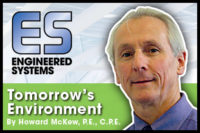Back in the 1970s, I was introduced to the phrase “client maintenance,” when the consulting engineering firm I worked for was revisiting how the company remained in contact with past clients. At the time, we had a roundtable discussion on “How can we better and routinely communicate with past clients?” The results of our quality control initiative still apply today as much as they did back then.
At the time, we did not want to jump to the solution as we saw it and instead spent time collecting pertinent data so we could come up with a sustainable solution plan.
Step 1: Data Collection
- Compile a list of past and present clients, noting that there were some clients we decided not to include in this list because we did not want to work with them in the future; and
- The list included individual’s titles and whether they were the decision-maker or the “gate-keeper” to the decision-maker.
Step 2: Data Analysis
- Review the data collected, edit the list, and mutually agree upon the final list;
- Input data into a client maintenance database separate from the standard customer database;
- Clients were placed in application categories, such as health care, educational, etc.
Step 3: Solution Planning & Implementation
- Determine the optimal person in the company to stay in communication with the client;
- Finalize the client maintenance script sheet to be used; and
- Agree upon client assignments and timelines for the year; and
- Create a standardized checklist per client, application, past services provided, potential future services clients could use, etc.
Step 4: Monitor, Measure, & Follow-up
- Report back to the company steering committee monthly with a one-page status report; and
- Follow-up on potential new leads and maintain a separate one-page status report on those leads.
Of course, traditional customer service includes inviting a client to lunch or dinner, some special event, playing golf, and/or sending company literature as a means of staying connected. While all of these ways of communicating with clients are useful as well as fun, there are some more subtle ways to provide more meaningful communication. Here are a few “tricks of the trade” when it comes to client maintenance:
-
In anticipation of a very hot and humid or cold day, the consultant should send out a text or email to clients asking them to make arrangements to collect pertinent HVAC system data, such as outdoor dry bulb and wet bulb, chilled water supply and return temperature, hot water supply and return temperature, etc. It’s important to note that a text or email may be better than making a phone call, because the client will have the requested information documents, whereas the client may be busy with other things when he or she receives the consultant’s call. Comment: of course the consultant needs to follow up the hot-cold weather email after receiving the information and providing a critique of this information and response back to the client as to what was learned from this data;
-
Good communication between a consultant and client may include a specific topic and/or new technology the client has inquired about. This gives the consultant an opportunity to schedule a meeting with the client to discuss the client’s inquiry. Comment: In addition to meeting with the client to discuss something of his or her interest, the consultant will often have an opportunity to find a technical article in an HVAC magazine, such as Engineered Systems, to copy and forward on to the client for their information; and
-
Inviting a client to a local ASHRAE monthly meeting (such as the ASHRAE summer or winter meetings to attend a specific seminar on a topic of interest) is another way of communicating and sharing the learning session.
Communicating with past clients gives one the chance to renew their acquaintance and get caught up on their HVAC business and current events. With current clients, often the client maintenance task is not as formal and/or scheduled because the consultant is probably communicating on a regular basis pertaining to a job in process. The bottom line is that it’s easier to retain clients and procure repeat business through a client maintenance process versus spending the same amount of time, if not more, pursuing the unknown.





